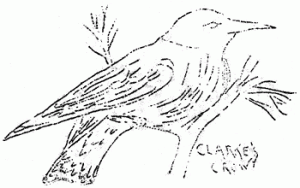A Migrant Tree
By Earl U. Homuth
Joseph Diller in his report on the geology of Crater Lake (Professional Paper, No. 3, Series B. Descriptive Geology, 22), mentions a phenomenon occasionally observed in the lake. A tree becoming dislodged may slide from the cliffs root foremost, and come to rest with the lower portion in the water. The root mass then becomes water-logged, and later the tree may be pushed out into deeper water and will float upright. A tree in this position has occassionally become lodged near the shore again and is often pointed out as evidence that the lake level has risen. Conclusions from one tree would hardly be acceptable, but nevertheless this is often the case.
A tree in the position described is now lodged near the shore of Wizard Island, on the southeast side.
Our Bears
By Earl U. Homuth
Bear signs and bear tracks in the snow were observed during the early season, but the familiar forms of last year have been a bit shy in appearing in public. Excellent photographs of one were obtained by the boat-boys near the hotel. A real bear-fight was staged near Headquarters one evening for the entertainment of all those present. The outcome was not determined, since the battle raged through the woods and over the ridge nearby.
Jemima, who was the well-known Jimmy until she appeard with two cubs last year, has not been seen, and doubts are being expressed as to whether she is still with us.
It is told of one of the rangers that while a guest at the cabin of another ranger, he lost his supply of cooked meat, this being the only way the host could persuade three visiting bears to depart. The points of etiquette as opposed to necessity in such a case may still be open for discussion.
–
Casual Bird Notes
By Earl U. Homuth
Two pairs of mountain bluebirds are known to have nested near the camp on the rim during past years, but neither has been found this year. However, the activities of a pair indicate that a nest may be discovered near the Community House.
A flock of Brewer blackbirds is reported by Ranger Fisher on the rim near the Lodge.
A mating pair of golden eagles was observed southeast of Union Peak in a part of the park rarely visited.
A black-chinned hummingbird is reported from Wizard Island. An observer in the Park has stated that he has seen more humming birds in the park than he had ever seen elsewhere under similar circumstances.
Clarke’s Crow. The young of this bird are now coming from their nests and the continual squalls are making the woods resounds. The fluffy fellows, as large as their parents, are common in the tourist camps. The Oregon or Grey Jays are not often seen near the rim and among the tourists the Clarke’s Crow or Clarke’s Nutcracker has taken the name of camp-robber.
The bird-list for the park for the past two years numbers seventy-five and many may be added.
The Collapse of Mt. Mazama
By Earl U. Homuth
While illustrating for the benefit of a small group on a field trip, the collapse of Mt. Mazama occurred to the satisfaction of all concerned, including the naturalist. The peak had been reconstructed with a pile of loose earth beside the trail. A stick was pushed into the summit of the pile, to produce a crater. This stick passed without resistance into a gopher hole below the intended crater, whereupon the ancient mountain promptly fell in upon itself, leaving a caldera of the proper proportion to serve as the setting for Crater Lake.
“Sulphur” on Crater Lake
By Earl U. Homuth
It is often observed from the Rim above Crater Lake, and from boats on the lake, that great masses of sulphur are floating on the water. This arouses the curiosity of the tourists and explanations are continuously in order. The entire region being of volcanic origin, the conclusion is generally offered that the sulphur is due to this fact. Examination, however, discloses that this wheat substance is pollen, probably of the lodgepole (P. contorta) blown in clouds from a distance and dropped upon the water in significant quantities to be visible from the cliffs above the lake.
Conies on Wizard Island
By Earl U. Homuth
During a trip to Wizard Island several conies were observed. These animals have often been reported from this unusual place. The question has often been raised as to how they got there, since this small crater is separated from the cliffs of the rim by a considerable expanse of water. Many conjectures may be offered, but most of them can hardly be accepted. It is suggested that they crossed on the ice or on snow slides from the cliffs above. There are records of that portion of the lake, between the Island and the nearest cliffs freezing, but this little animal would not be seeking new environments at that time of the year.
Signs of conies may be found near the bottom of the crater on the Island, on the north side, near a cairn which has been piled there. A few moments of waiting will be rewarded. On this occasion one cony was observed at less than three paces.
***previous*** — ***next***
–


